-
I went to hospital because of my heel pain, and a doctor said it is plantar fasciitis. What is plantar fasciitis?
-
Plantar fasciitis is one of the most common cause of pain in heel. There is a thick layer tissue runs from your toes to bottom of your foot, and it connects your heel bone to your toes. When that layer on the bottom of your foot have inflammation, it causes pain.
Plantar fasciitis is commonly found in middle-aged woman. Sometimes young male athletes have plantar fasciitis as well. It causes stabbing pain that usually being felt when you walk first steps in the morning. However, this stabbing pain decreases as you move. After long periods of standing or sitting, you may feel the pain again when you walk or stand up.
Usually it is cured with rehabilitation, insole, or pain killer, but some people have difficulty healing and choose extracorporeal shock wave treatment or surgery.
-
What is the symptom of plantar fasciitis?
-
Usually people who have plantar fasciitis feel stabbing pain when they wake up and walk first steps, and it is common that the pain decreases as they move to get ready for a day. However, when you move after a long period of sitting, the stabbing pain may be recurred.
It is common that you feel pain after working-out or exercising at beginning phase of plantar fasciitis, not in the middle of exercising.
-
Why plantar fasciitis occurs? What is the cause of this?
-
Plantar tendon is stretched like a string between your heel and your toes and have a role of shock absorber when you walk. If there is a lot of stress on the plantar tendon such as weight gain or running, it can cause a small injury around heel. If the injury gets cured soon, there will not be any problem. However, as we get older, the recovery speed decreases and becomes harder to cure perfectly.
Once we have an injury, our body increases blood vessels to cure the damage, but our body also increases nerves along with blood vessels.
The stabbing pain in heel can be caused by these problem blood vessels and nerves, which are not found in healthy heels.
Check more about problem blood vessels.
-
I have a heel pain for more than a half year, and I believe it is plantar fasciitis. Is my case severe? How long does it take to be cured?
-
Some patients get improved without any treatment, but it is also common that some people have difficulties to remove the pain. In severe case, you may feel pain for a year or even more. If you receive an adequate treatment, it is highly likely that you can recover the symptom. However, there are still many cases that are treated inadequately, and cannot be improved.
As noted above, if the cause of your pain is plantar fasciitis, there should be problem blood vessels which are irregular and unnecessary in heel. It is important to eliminate the problem blood vessels to remove your pain. Please check the following page as well for more details.
-
Is there an effective stretch for plantar fasciitis?
-
In order to reduce the stress on the attachment area due to the plantar fascia being stretched, it is necessary to maintain the flexibility of the plantar fascia itself. Massaging the sole of the foot can increase the flexibility of the plantar tendon. Massage the area around the plantar tendon with the toes flexed. However, do not rub the painful heel area.
You can also stretch the lower leg triceps (calf muscle) to relieve stress on the plantar tendon through the heel bone. In a standing position, open the leg back and forth, the painful leg is on the back side, and place your weight on the front leg while keeping the heel of the back leg on the floor. You should then stretch and feel tension in some of the muscles of the back calf. Stretch in this position for 15 seconds.
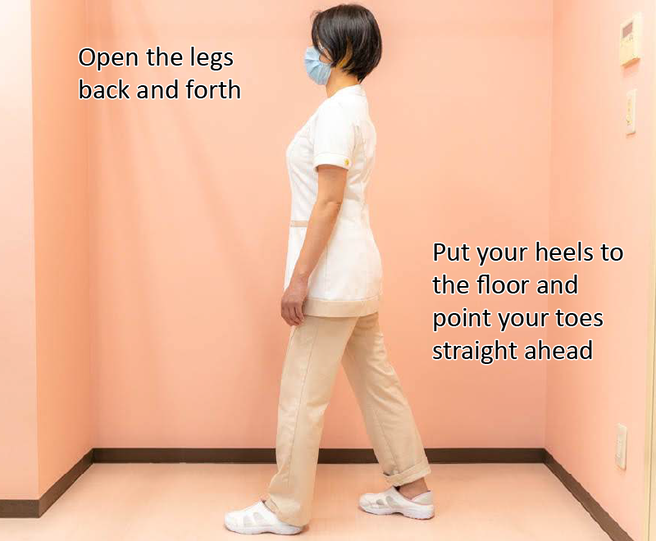
-
Is taping effective for plantar fasciitis?
-
Effective taping depends on the condition of your foot. For people with flat feet, taping to raise the arch of the foot is effective.


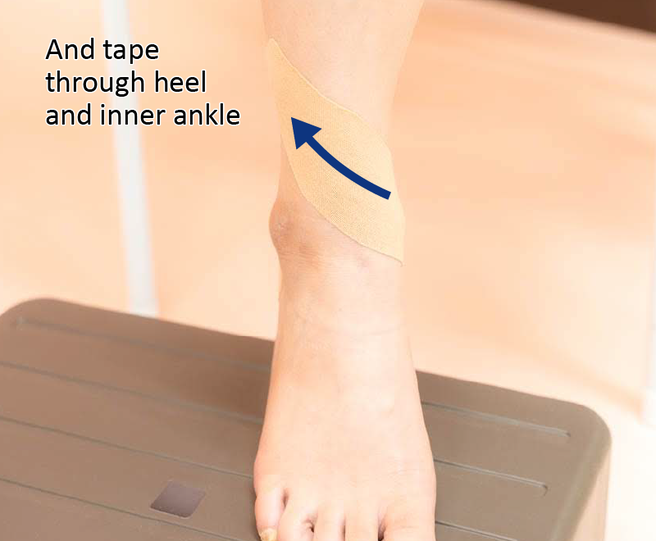
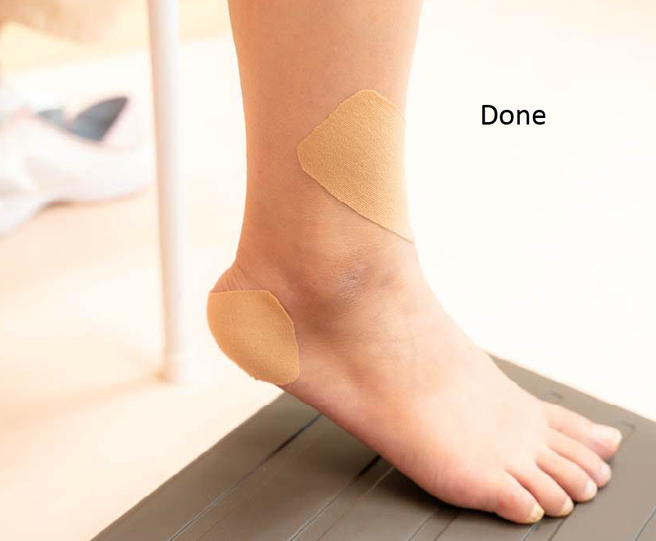
In case of high arches, it is effective to reduce the stress on the plantar tendon by taping the sole of the foot from outside of the heel to the base of the big toe.
-
I was asked to have extracorporeal shock wave treatment for plantar fasciitis. How does it work? What are the risks of this treatment?
-
There are several academic researches on the outcomes of extracorporeal shock waves as a treatment of plantar fasciitis. The results are actually varied, but on average, there is more than a 40% chance that the pain will be reduced to less than 50% of its severe condition. Thus, it cannot be said that the extracorporeal shock wave removes the pain for every patient.
Serious complications rarely occur with extracorporeal shock waves. However, the treatment itself is painful. Side effects such as discomfort, pain, and bruise have been reported. There are also reports of bone deformations in foot and rupture plantar tendon due to damage of normal nerves by shock waves.
-
What kind of surgery is available for plantar fasciitis?
-
Endoscopic surgery is available. This surgery is available only at a specialized medical institution. Also, there are some others such as surgeries to remove the plantar tendon or osteophytes. However, the success rates of these surgeries are reported not so high and do not reliably take away the pain.
-
I had extracorporeal shock wave for plantar fasciitis, but it did not improve. Actually, it became more painful. Are there any other effective treatment for plantar fasciitis?
-
The shock wave treatment does not approach the cause of pain directly. Thus, there are some patients who had it do not improve well. As noted above this page, plantar fasciitis is a disease which increase problem blood vessels with nerves, and they become causes of pain. Especially if the pain is severe for more than a few months, it is difficult to heal due to problem blood vessels.
There is a new treatment to improve these blood vessels. It only takes 5- 10mins for the treatment. Check “Injection to reduce problem blood vessels” in the link below to see more details.
Author

-
‐ 奥野 祐次 院长 -
我最初是一名放射线科医生,在研究生阶段专注于病理性血管新生的相关研究。基于这一研究成果,我于2012年以第一作者身份在《Nature Medicine》期刊上发表了关于相关基因的论文。此后,我以此为基础,开发出一种适用于变形性膝关节炎、五十肩等慢性运动系统疾病的全新栓塞治疗方法,并率先在全球范围内报告了该疗法的安全性与有效性。目前,该治疗方法已在国际间得到进一步的研究与应用。
‐ 个人经历 -
2006–2009年 横滨市 Clinica ET 放射线科 专科培训医师
2009–2012年 庆应义塾大学 综合医学研究中心 研究员
2012–2015年 江户川医院 IVR科 临床研究医生
2015–2017年 江户川医院 运动系统导管治疗中心 主任
2017年–現在 奥野医院 总院长
Latest posts
 Nov 25, 2023Plantar Fasciitis FAQ
Nov 25, 2023Plantar Fasciitis FAQ Nov 25, 2023Tennis Elbow FAQ
Nov 25, 2023Tennis Elbow FAQ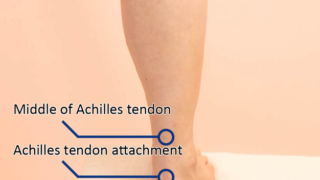 Nov 25, 2023Achilles Tendinitis FAQ
Nov 25, 2023Achilles Tendinitis FAQ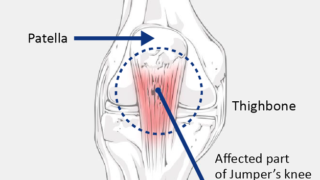 Nov 25, 2023Jumper's Knee FAQ
Nov 25, 2023Jumper's Knee FAQ